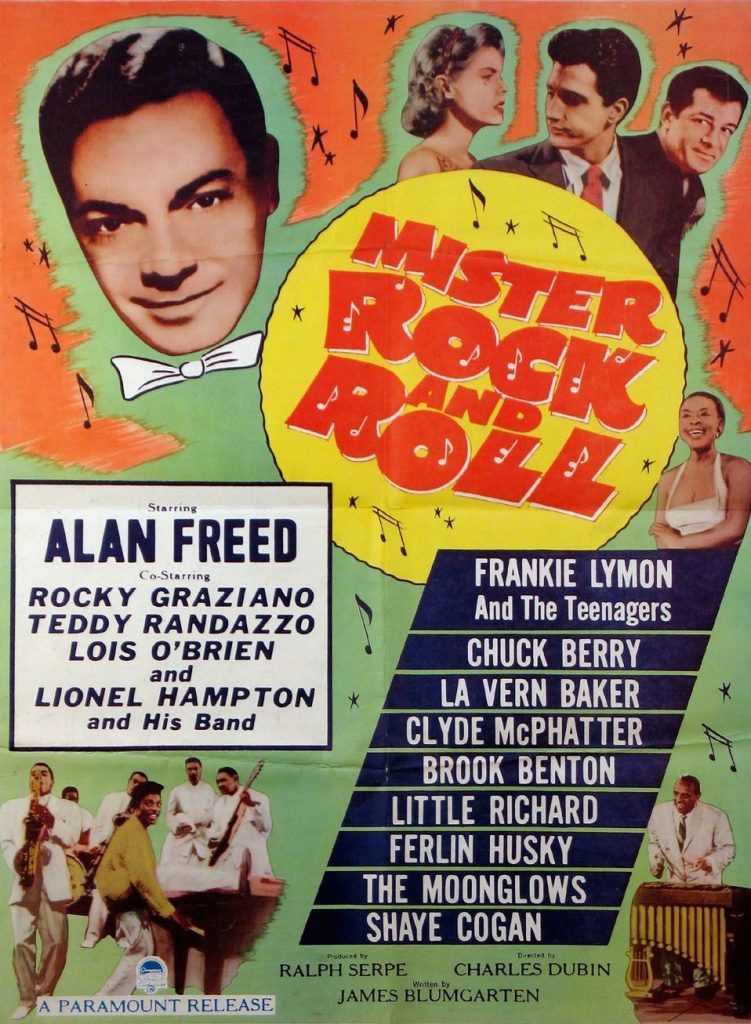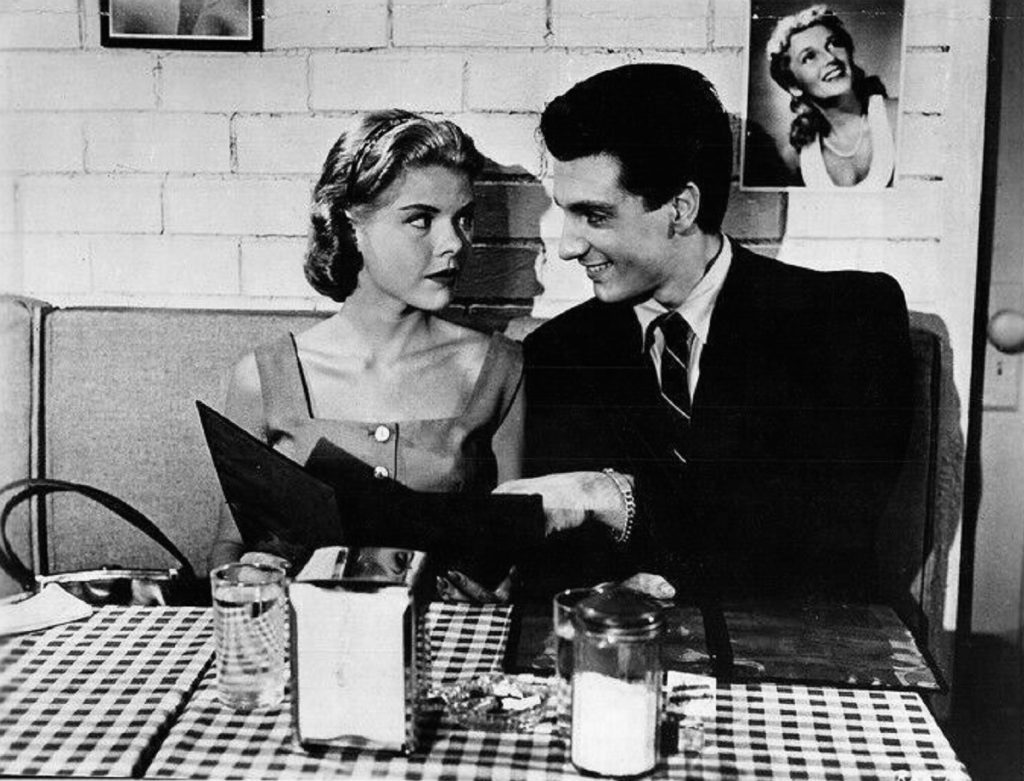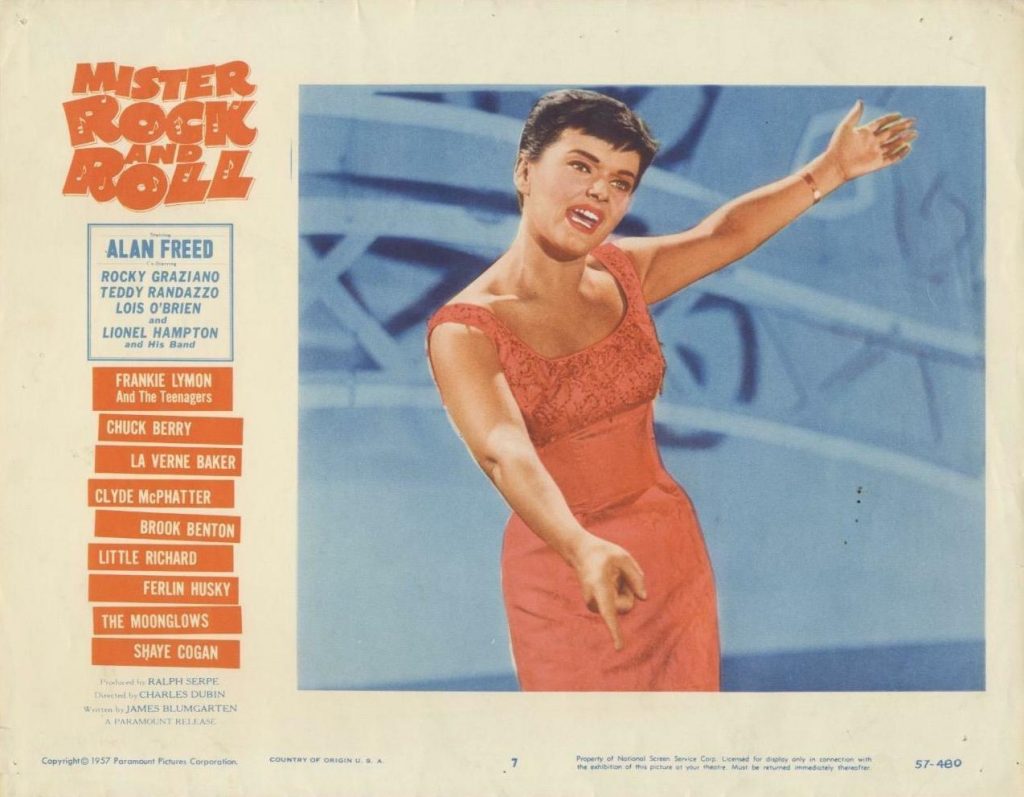
Mister Rock and Roll (USA, 1957) 86 min B&W DIR: Charles Dubin. PROD: Ralph Serpe. SCR: James Blumgarten. DOP: Maurice Hartzband. CAST: Alan Freed, Teddy Randazzo, Lois O’Brien, Rocky Graziano, Jay Barney, Al Fisher, Lou Marks, Leo Wirtz, Ralph Stantley, Lionel Hampton, Ferlin Husky, Frankie Lymon And The Teenagers, The Moonglows, Little Richard, Brook Benton, Chuck Berry, Clyde McPhatter, LaVern Baker, Shaye Cogan. (Paramount Pictures)

Open on a hard key light on singing talent in foreground, non-descript black background in Paramount studio. Blast of offscreen brass:
“Everybody lend an ear!
Mister Rock and Roll is here.”
“First there was Mister Blues, Mister Dixieland, Mister Jazz”, the chanteur continues, as the music plays accordingly to the style of the moment, and animated silhouettes of blues and jazz players appear on the screen.
“Bring them all together- you’ve got Mister Rock and Roll”… and you have a mini art deco origin of the music known as rock and roll, as the man scrunches together the primitive cartoon outlines, to form another. This mini-epic synthesizes the styles blended to form that taboo form of music which allegedly contributes to juvenile delinquency and other such atrocities.
Teddy Randazzo’s opening act at the Paramount (where else?) performing “Kiddio” (with an integrated band) is what divides the slim narrative into two parts: the obligatory love story, the rock and roll numbers. His buddy, DJ Alan Freed (playing himself in the third of five movies he made to showcase rock and roll acts) gives him a backsell before he takes off to his shift at WINS radio.
The cardboard plot features crooning idol Teddy Randazzo’s love-at-first-sight for journalist Carol Hendricks from World Magazine (played by Sandy Stewart lookalike Lois O’Brien) being soured when her piece on rock and roll is mutated by her ruthless editor Joe Prentiss (Jay Barney). The filmmakers wisely turn this melodrama into filler between what the teens really came to spend their allowance money on: all those groovy acts, circa 1957; the hip, the hot, the legendary, the Billboard footnotes, the now forgotten.

Alan continues playing the hits even if Teddy and Carol are not listening from the radio in the Styrofoam-brick basement café. As we will see, all of Freed’s footage seems to suspend time. His segments spearhead the musical acts, and his on-air commentary advances that secondary thing called the plot. As the records spin, we are introduced to some of the world’s first rock videos. Years before MTV, these modest Alan Freed movies were already anticipating the technique of music videos.
Frankie Lymon and the Teenagers sing “Love Put Me Out of My Head” on a half-constructed set (with a ladder in the background), followed by Shaye Cogan (a Patti Page soundalike) doing the “Get Acquainted Waltz” in front of the archetypal black backdrop. Then we are given The Moonglows doing “Barcelona Rocks” in little sombreros at a cheap casa set.

This valuable documentation of music history is interrupted by a trek to the real world, as Joe the editor growls how much these kids are “a bunch of hare-brained delinquents”. Okay Joe, whatever- back to Freed. Ferlin Husky does country crossover with “This Moment of Love”, followed by Chuck Berry performing “Baby Doll” straight towards the camera- even the cutaway of his shuffling feet are shot from the same setup. After “If I Only Had Known”, by Brook Benton, these two narrative threads converge.
The Montage Midsection of Musicals incorporates platters on a turntable with images of Alan over the mike, newspaper headlines disclaiming rock and roll, Joe madly typing. Once again the plot rears its head as Teddy believes that Carol set him up for Joe’s editorial attacks; he is especially hurt because Freed (the obvious target) had put him on the map. “You want me to show you my switchblade?!” he blurts to the incredulous Carol. Alan, meanwhile, rebuts Joe on the air, albeit it a cryptic way. (Isn’t it funny how those who hate rock and roll have that very station tuned in, especially when they about to be referred to on the air?)
Suddenly time is suspended as we look back on how Alan got started in the biz, from hearing kids digging rhythm-and-blues in a listening booth at the record store, to coining the phrase “rock and roll”, to Little Richard doing “Lucille”, to Rock and Roll Coronation Night, featuring Lionel Hampton’s band with his showstopping “Hey Babu Ree Bop” (which is still rousing despite being edited from two camera set-ups in long shot).
But it’s time for Alan to play more records and it’s back to Friday Night Videos circa 1957. LaVern Baker sings “Humpty Dumpty Heart” to her boyfriend who acts like a chimpanzee (the film’s one display of racial stereotyping, and it’s cringe-inducing), followed by Ferlin Husky with “Make Me Live Again” and Clyde McPhatter on “Rock and Cry”.

“Do you, Joe Prentiss, remember when you were a teenager?” Alan booms over the airwaves. Just to show that teenagers are not the insensitive delinquents that Prentiss stereotypes them as, he urges the kids who have tuned in to check out an upcoming revue- the proceeds of which would go to the Heart Fund Drive. Right out of Frank Capra or Hugo Haas, the kids turn out in droves at the charity show. For their (our) pleasure there is another rousing set of Lionel Hampton, then LaVern on “Love Me Right In the Morning.”
Narrative takes its toll in a fake car interior as Joe Prentiss gives Carol a cheque to take to the show. “When I make a mistake, it’s a beaut.” Is love restored? Are there more rock and roll numbers? (Yes, significantly, another Frankie tune, “Fortunate Fellow”.)

Within its low-budget packaging, Mister Rock and Roll is actually a profound synopsis of the music. Today, the real rock and rollers in the film would of course be seen as Chuck Berry, Frankie Lymon and Little Richard. But all the artists in the film convey one aspect of music that forms this Heinz 57 of folk, R&B and jazz (with 40s Harlem Jump music being the ancestor of the 1998 swing craze, which was also riffing 50s rockabilly). By accident it is ahead of its time, especially when Freed introduces Hampton as a guy “loved by two generations”.
Its formula, despite the impressionistic narrative, is still the good old “boy meets girl” musical that the kids’ parents could recognize. Mister Rock and Roll adheres to that world where the jilted boy reacts to his woman doing him wrong by bursting out into song, where Teddy’s blue mood is alleviated by the comic relief sidekick Rocky singing “I told her I loved her a tousand times”, where even the non-musicians like Carol suddenly exhibit singing talent, where you could still smoke onstage and in the radio booth, where offscreen orchestras accompany tunes sung in a small basement coffee house, and where there is curious studio echo in a cramped dressing room. In its own way, this film also speaks to two generations.
This is the fourth of the five Alan Freed pictures, which include Rock Around the Clock (1956), Don’t Knock the Rock (1956), Rock, Rock, Rock! (1956) and Go, Johnny, Go! (1959).
